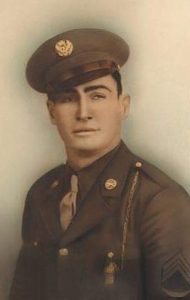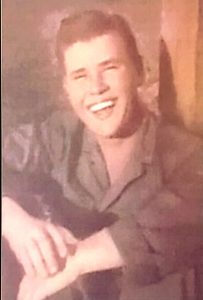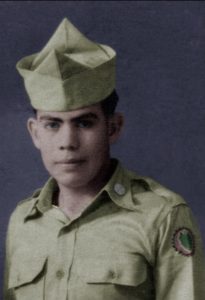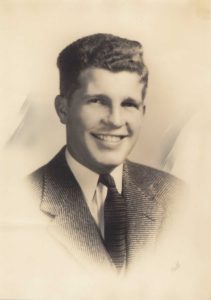West, John William
Army Corporal
John William West, age 31, from Texas, Tarrant county.
Service era: Korea
Date of death: Thursday, November 2, 1950
Death details: During the last week of October 1950, Republic of Korea (ROK) Army forces under the control of the U.S. Eighth Army were advancing deep in North Korean territory, approaching the Yalu River on the Chinese-Korean border. Chinese Communist Forces (CCF) struck back in a surprise attack, engaging the ROK 1st and 6th Divisions near Unsan, some sixty miles north of Pyongyang. The U.S. 1st Cavalry Division, with the 8th Cavalry Regiment in the lead, was rushed forward to reinforce the ROK units in the Unsan area. On November 1, the regiment’s 1st Battalion took up positions north of Unsan, while the 2nd Battalion moved to guard the Nammyon River valley west of town, and the 3rd Battalion was placed in reserve at the valley’s southern end. Sergeant John William West joined the U.S. Army from Texas and served in the Medical Company of the 8th Cavalry Regiment, 1st Cavalry Division. On November 2, 1950, he and other members of the Medical Company were supporting 8th Cavalry Regiment elements near Unsan when they received orders to withdraw. Sergeant West went missing during the withdrawal, though circumstances surrounding his loss are unknown. He was not reported as a prisoner of war, and he was not identified among remains returned to the U.S. following the war. Today, Sergeant West is memorialized on the Courts of the Missing at the National Memorial Cemetery of the Pacific.
Source: National Archives, Defense POW/MIA Accounting Agency

 Death details: On August 14, 2018, the Defense POW/MIA Accounting Agency (DPAA) identified the remains of Private First Class Mathis O. Ball Jr., missing from the Korean War. Private First Class Ball joined the U.S. Army from Texas and was a member of M Company, 3rd Battalion, 21st Infantry Regiment, 24th Infantry Division. On July 11, 1951, his unit was in a defensive position near Chochiwon, South Korea, when they came under attack from North Korean forces. M Company was forced to withdraw, and PFC Ball was reported missing in action once the unit regrouped the next day. He was not seen to fall during the fighting, and was never reported to be a prisoner of war. In October 1951, a set of remains were recovered from an isolated unmarked grave near Chochiwon, and were buried at the United Nation Military Cemetery at Taejon, South Korea. These remains were disinterred from the cemetery in 1951; however, they could not be identified at the time, and were reburied as unknowns at the National Memorial Cemetery of the Pacific. In 2017, advances in forensic techniques prompted the reexamination of these remains, and they were eventually identified as those of PFC Ball. Private First Class Ball is memorialized on the Courts of the Missing at the National Memorial Cemetery of the Pacific.
Death details: On August 14, 2018, the Defense POW/MIA Accounting Agency (DPAA) identified the remains of Private First Class Mathis O. Ball Jr., missing from the Korean War. Private First Class Ball joined the U.S. Army from Texas and was a member of M Company, 3rd Battalion, 21st Infantry Regiment, 24th Infantry Division. On July 11, 1951, his unit was in a defensive position near Chochiwon, South Korea, when they came under attack from North Korean forces. M Company was forced to withdraw, and PFC Ball was reported missing in action once the unit regrouped the next day. He was not seen to fall during the fighting, and was never reported to be a prisoner of war. In October 1951, a set of remains were recovered from an isolated unmarked grave near Chochiwon, and were buried at the United Nation Military Cemetery at Taejon, South Korea. These remains were disinterred from the cemetery in 1951; however, they could not be identified at the time, and were reburied as unknowns at the National Memorial Cemetery of the Pacific. In 2017, advances in forensic techniques prompted the reexamination of these remains, and they were eventually identified as those of PFC Ball. Private First Class Ball is memorialized on the Courts of the Missing at the National Memorial Cemetery of the Pacific. Death details: On July 5, 1950, Task Force Smith, the first U.S. ground element to engage North Korean People’s Army (NKPA) troops, was defending a position north of Osan, South Korea. The Task Force’s goal was to delay enemy forces by blocking their movement down the road south from Suwon to Taejon, which was a major avenue of advance for the NKPA. That morning, the Task Force was engaged by a column of enemy tanks. The anti-tank weapons that the infantrymen employed were ineffective, and a large number of tanks broke through their position. Task Force Smith was forced to withdraw to the south, suffering heavy casualties in the process. Private First Class Anselmo Zamora, who joined the U.S. Army from Texas, served with B Company, 1st Battalion, 21st Infantry Regiment, 24th Infantry Division. His unit was part of Task Force Smith, and he was captured by enemy forces on July 5. He was forced to march to the Apex prison camps in North Korea, and died of malnutrition at the camp at Hanjang-ni on February 24, 1951. He was buried near the camp; however, his remains were not identified among those returned to U.S. custody after the ceasefire. Today, Private First Class Zamora is memorialized on the Courts of the Missing at the National Memorial Cemetery of the Pacific.
Death details: On July 5, 1950, Task Force Smith, the first U.S. ground element to engage North Korean People’s Army (NKPA) troops, was defending a position north of Osan, South Korea. The Task Force’s goal was to delay enemy forces by blocking their movement down the road south from Suwon to Taejon, which was a major avenue of advance for the NKPA. That morning, the Task Force was engaged by a column of enemy tanks. The anti-tank weapons that the infantrymen employed were ineffective, and a large number of tanks broke through their position. Task Force Smith was forced to withdraw to the south, suffering heavy casualties in the process. Private First Class Anselmo Zamora, who joined the U.S. Army from Texas, served with B Company, 1st Battalion, 21st Infantry Regiment, 24th Infantry Division. His unit was part of Task Force Smith, and he was captured by enemy forces on July 5. He was forced to march to the Apex prison camps in North Korea, and died of malnutrition at the camp at Hanjang-ni on February 24, 1951. He was buried near the camp; however, his remains were not identified among those returned to U.S. custody after the ceasefire. Today, Private First Class Zamora is memorialized on the Courts of the Missing at the National Memorial Cemetery of the Pacific.